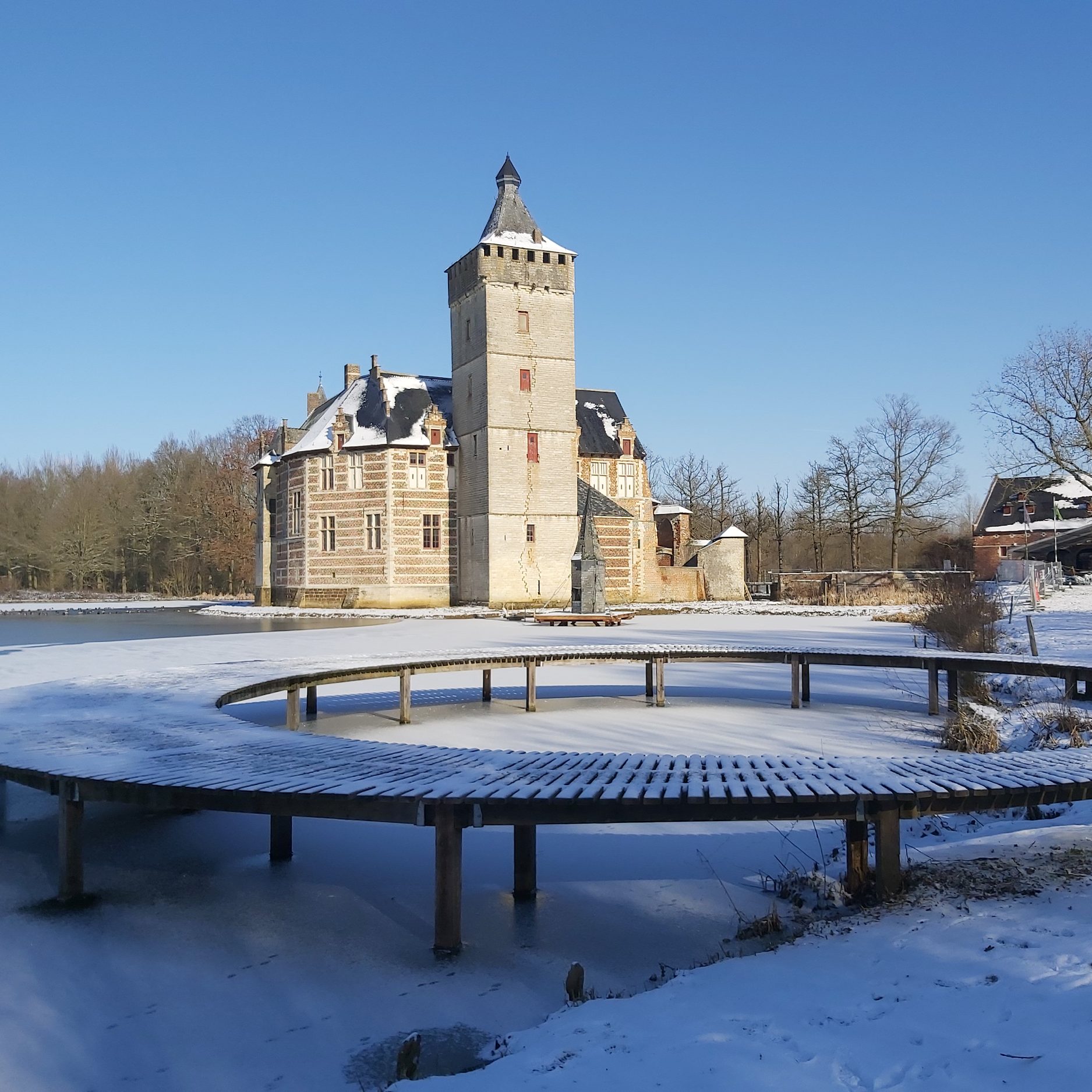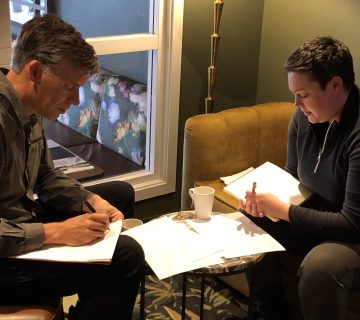The newly formed Team Belgium shares their love for the Castle of Horst and how interpretation of its heritage has changed and adapted.
Hello fellow members of Interpret Europe, we are Team Belgium – three heritage professionals who crossed paths at the beautiful 17th century Castle of Horst. Located in the centre of Belgium (near the city of Leuven), this noble residence or summer palace with a 15th century Donjon, is surrounded by a protected cultural landscape. We share a love for this place. Not only because the stunning medieval and renaissance wall-paintings and baroque stucco-ceilings excite our imagination, but also because we share common stories at the castle and its beautiful nature. And that’s what it’s all about, isn’t it?
Let’s set up a team, we thought. Let’s excite other people to make connections with heritage. Because we strongly believe in the importance of heritage for society. A society where strong and warm communities are built on mutual connections with heritage places and respect for each other’s meaning-making. We believe heritage interpretation is the tool to make this happen. So, here we are, Team Belgium was born.
Besides making a start with a stronger network for interpretation professionals in Belgium, we also want to introduce ourselves to the Interpret Europe network. So as a conversation starter, please find below a short story of how our beloved Castle of Horst and its community found a way to interact with its visitors during its closure – because of restoration in 2017 and during the current pandemic.
The Castle of Horst – Interpretation during its closure and the coronavirus pandemic
Since the building fever by widow Maria-Anna Van den Tympel in the mid-17th century, the castle hasn’t been altered much. Because of that, the Castle of Horst is today a very authentic, almost magical castle, managed by Herita vzw – The Flemish National Trust. Unfortunately, the castle was closed to the public in 2017 due to safety reasons, awaiting a much needed and thorough restoration campaign. Nevertheless, the heritage site is still a very popular recreational location, for locals but also visitors from all over Belgium and Europe. The 17th century coach house on site accommodates a restaurant and the visitor centre with heritage shop. The visitor centre was turned into an information-point during the first summer after closing.
The central questions were: How to stay connected with the local heritage community and visitors with a long restoration campaign ahead? How to give meaning to this historical place when people are not allowed to go inside or even visit the courtyard? And how to prevent losing the work that had been done since 2014, such as an interpretive family tour and the popular programmes for schools?
This is where a group of volunteers called the Horst Society stepped in. As long-term committed volunteers and guides, they felt the need to organise a bottom up incentive – also because the site had no professional staff. The Horst Society focuses on two things: keeping the heritage shop open, offering a wide range of local speciality products, and organising activities and small events in which the castle and its heritage value form the core content. Herita vzw realised only during the time after closing how important the continuity on site was for both the local community and reputation of the site. A renewed collaboration was born.
Initially, activities such as alternative guided tours around the castle (focusing on the cultural heritage or nature), workshops for children and historical dancing workshops filled the gap. The volunteers and guides, dressed-up as historical figures, attracted a lot of attention on site. They became the point of contact for questions about the planned restoration works. They approach the visitors to give explanation or sometimes even offer live interpretation.
The challenge lay in continuously creating an experience when people are not allowed to go inside or even visit the courtyard. In September 2019, Herita and the Horst Society organised a special edition of Open Monuments Day, bringing the interior of the castle to the outside, by printing the famous stucco ceiling on a large canvas. They created a 17th century banquet hall feast, with the extra effect that this stucco ceiling could be touched and looked at from a close distance by the audience. The volunteers of the Horst Society received the visitors dressed as historical figures, which drew the attention of many visitors who often just come to relax in the beautiful atmosphere.
Of course, Covid-19 has changed a lot, but maybe not in the way you would expect. Since the start of the corona crisis in March 2020, the site became a Flemish Top 10 site of most popular hiking spots. Suddenly the big disadvantage of a closed castle became an asset, hence the previous experience of bringing heritage interpretation outside the castle came in handy. An autonomous and covid-proof family trail with interpretive assignments was set up to encourage families to connect with each other, the exterior heritage elements of the site and the stories of the castle. We benefitted from the new need for covid-proof outdoor activities and were very pleased to receive hundreds of families during the summer. The success of the family trail gained a renewed energy for the volunteers, who had been improvising for many years. In 2021, three family outdoor trails will be organised in a way that families are stimulated to come back to the site and discover new aspects of the richness of the heritage that Horst offers.
In 2020, the long anticipated restoration campaign of the castle finally started. During the years to come, Herita vzw, together with the committed volunteers, will invest in thorough communication and interpretation of the (mostly very technical) restoration works to the public. Through yard visits, blog-articles and on-site restoration-ateliers, they will aim to create more insight and initiate more community-wide support. During this period of restoration, the Horst Society will keep on telling the stories of this place and its inhabitants. Today, Horst is more than a ‘closed castle’ but a dynamic heritage site.
Laila De Bruyne is the former knowledge sharing coordinator at Herita. She is currently freelancing in cultural and heritage community building projects and is IE’s Country Coordinator Belgium. Get in touch with her at: laila.debruyne@interpret-europe.net.
Barbara Struys worked for Herita as site manager of the Castle of Horst and audience development coordinator between 2014 and 2017. She is an active member of the Horst Society. Currently she works as a knowledge sharing coordinator for cultural education for publiq vzw. Barbara also offers support to heritage organisations as a freelancer in heritage interpretation for families and coaching of groups of guides. She can be contacted at: barbara@gidsenhumus.be.
Helena ten Berge holds an MsC in Conservation of Monuments and Sites and currently works at Herita, helping to rebuild the local heritage community by actively interpreting the planned and ongoing restoration works to the public. She is the coördinator of the crowdfunding project for the Castle of Horst. Get in touch with her at: helena.tenberge@herita.be.
To cite this article: De Bruyne, Laila and Struys, Barbara and Helena ten Berge (2021) ‘Interpreting a castle during closures’. In Interpret Europe Newsletter 1-2021, 17-18.
Available online: https://interpret-europe.net/wp-content/uploads/2021/03/Newsletter-Spring-2021.pdf




